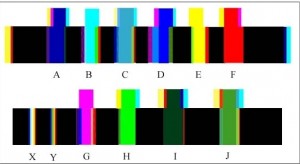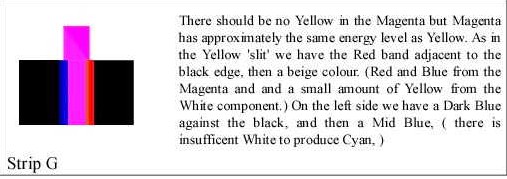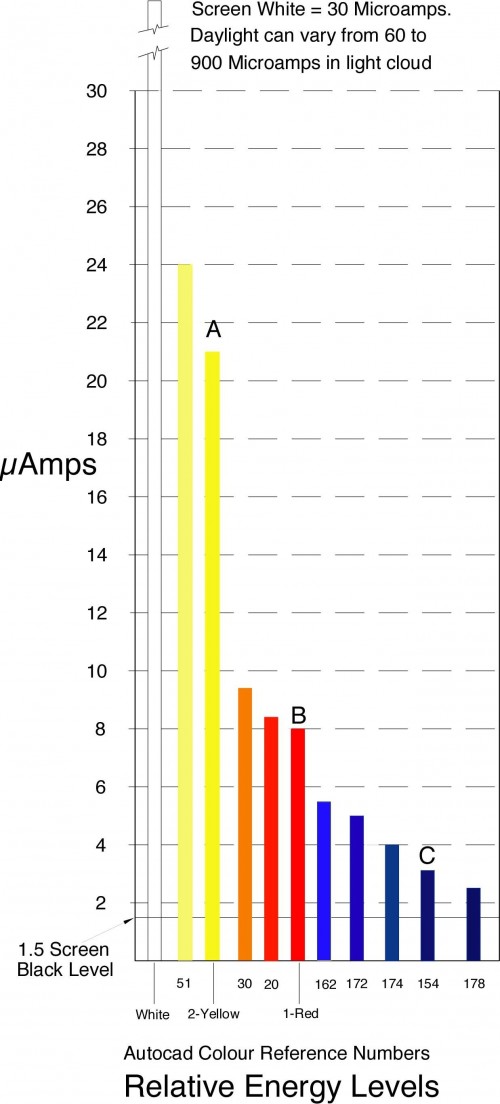-
Design Problems of Modern Road Lighting.
Posted on December 14th, 2010 No commentsIf you are driving along a road at night you have a visibility problem. If there are no street or road lamps you are dependant on the relatively small amount of light reflected back from your headlights to see and identify objects in front of you. However, your eyes rapidly adjust to the low ambient light conditions and your visibility improves. However, the lights of any traffic coming towards you overrides this and your eye adjusts again to handle the new light intensity. Of the light energy entering the eye now, only a small percentage is coming from the low energy light receptors (rods) that allow us to see in low ambient conditions, and the higher energy light from oncoming headlights effectively swamps the signals to the brain. This affectively blinds us.
However, as the high energy receptors(cones) are mainly concentrated in the centre of the retina (the fovea), we can reduce their effect by moving our eyes to one side (about 10º) which reduces the efficiency of the rods and allows a greater percentage of the low energy rods to transmit their signals to the brain. This allows us some improved visibility.
If the road or street does have lighting, you have a different set of problems. In modern street lighting your visibility is reduced by the lighting itself, which is designed to suit the pedestrians rather than the motorists, a situation that actually endangers the pedestrians.
Modern street lighting is designed to give an even spread if light across an area, which is beneficial to the pedestrian.
However, when you are driving at night along a lit road you are conscious that there is a ‘blind spot’ under each lighting unit. Oddly, these are the areas that receive the most light. A pedestrian crossing the road in these areas will be be very difficult to see by approaching motorists.
The light shining downwards from the lamp is mostly converted to heat or reflected up into the sky, which is why this area appears as a blind spot to motorists. This also means that the energy used to illuminate this area is wasted. An airliner or helicopter has a better view of the road than the motorist.
A further problem is light intensity. If you are walking at night and someone shines a torch at you , you are effectively blinded, because the light intensity of the torch beam is far greater than the far lower ‘ambient’ light, (you are blinded by a bright spot’). Driving on roads that are lit by modern light units, means that your vision is affected by many ‘bright spots’ created by the road lights shining in your eyes.
The eye can adjust to dim ambient conditions, but these bright spots prevent this adjustment from taking place. No bright spots should be visible within 15º of the eye-line. In general, you should not see any direct light from more than one road lamp and this should only be visible by swivelling the eye by 15º. On many roads you can see up to 50 ‘bright spots’ created by badly designed lighting systems.
These problems were known and understood 50 years ago before road lighting design was transferred to ‘architects’. Architects were involved in making ‘pretty’ lamp standards rather than efficient ones. As long as they looked all right in daylight that was OK. The earlier lighting units had adjustable shades that allowed control over the areas covered. This allowed the overall lighting system on a road to be adjusted for best results.
For maximum driving (and pedestrian) safety all road lights should shine in the same direction that the traffic is travelling. Although relatively simple to do on dual carriageways, (With the aid of shields that ensure that light is not visible from the opposite carriageway), it is more difficult on narrow roads. However, the cost of modifying modern lighting would be justified by the huge savings in power costs.
It would also address the problem of light pollution at night discussed in the news item below.
HID Headlights (Bi-zenon)
The problem with these is mainly with the design of the light fittings themselves. If the higher energy beam was properly controlled they would be acceptable. Unfortunately, there is a large part of the beam energy that does not satisfy the dipped beam requirements.
The main culprits are those cars with wrap round headlight designs, which allow a large amount of light to be shine outside the dipped beam area even though the centre of the beam focus may be correct. This presents a problem in that test stations do not have the correct equipment to check this. We are left with a dangerous situation where HID headlights are able to pass current MOT standards even though they cause greater road dangers. This presents the government with the choices of forcing the manufactures to produce expensive modifications to the cars, banning the cars from British roads, or refitting them with traditional headlights. The moral situation is that the cars should be taken off the roads until the problem is solved in a satisfactory manner. However see comments below.
Sidelight Light-Emitting Diodes. (LEDs)
Even the LED sidelight clusters have a detrimental affect on your vision. Over the last week while on holiday I have been checking on this problem. Even in daylight conditions looking at the LED clusters for a few seconds leaves an impression on the retinal cones that can last up to 30 seconds. This reduces your visual acuity. At night it is far more dangerous because this lingering after-image reduces the effect of turning your eyes to allow the retinal ‘rods’ to handle the dark conditions.
Note: It may be that the ‘Sidelight’ LEDs are actually the cause of this problem, and not the main headlight unit. Although LEDs use less power, the light is at a greater intensity that is higher than normal daylight. The Ministry of Transport or motoring organisations should carry out simple tests to check this. Fitting a change-over switch in the lighting system so that operation of the main headlights cuts out the sidelight clusters would probably solve the problem.
This is particularly evident on many imported cars that have sidelights on at all times.
This posting was triggered by the following news item.
www.bbc.co.uk/news/science-environment-11990737 (Road lighting)
and http://www.bbc.co.uk/news/uk-13147629 (HID headlights)
Author; Brian Williams
-
How we Manage to See.
Posted on November 1st, 2010 No commentsImagine you are in a toy shop at night but with all the lights on. You are all alone and everything is still. You look across the room at a large doll with Yellow hair, a multi coloured striped dress and black shoes. How are you actually seeing her?
According to the physicists it is due to photons traveling from the doll to your eye.
OK, but what is a photon?
According to the physicists it is, (and I quote) “A quantum of light or of electro-magnetic radiation……..”. Chambers Dictionary of Science and Technology. [Not their fault, that’s what they were told by the physicists.]
Do you understand it now?
Of course not, they tell you that to stop you from asking ‘really difficult’ questions. If you persist and make a nuisance of yourself, you may get the admission that the physicists consider that a photon is ‘a squiggly line that can be like a particle.’, the squiggly bit is the ‘Wavelike nature of light’. Check in your physics books and you will find graphic illustrations of these strange items.
Never mind, you will not get any sensible explanation so let us return to our toy store.
We are looking towards the large doll and we see it by the squiggly lines, sorry, photons, that are traveling from the various lights to the doll and then traveling to your eye. Simple, isn’t it, now you know how we see things, according to the physicists.
It is simple if you are not interested in physics, and it will do for the children.
However, you have billions of photons traveling in all directions from the lights. These photons are reflected off all the toys and walls and floor and again scattered in all directions. During all this scattering they change from white photons into yellow, red and blue photons. Some remain as white photons. According to the physicists we also have purple, light green, dark green, mauve, pink, cyan, magenta, grey, khaki etcetera. photons. [Odd really, if white light is composed of all the other colours, then a white photon would have to split into 100s of different coloured photons!]
Now ask your physicist how all the white photons change into differently coloured photons. Or better still, don’t, because you will not get an answer.
Now consider a a single Red photon travelling from the doll to your eye. It is crossing the paths of billions of other photons, of different colours, all travelling in different directions. Apparently it does this without colliding with, or being affected by, all the other photons.
Apparently, there is so much space between all these photons that only a very few are affected by collisions and therefore we don’t have a problem!
But what about the billions of atoms and molecules that stand in the path between the doll and your eye? Do they not have any affect on the photons? Do photons pass unimpeded through them?
Let us review the description of a photon, “A quantum of light or of electro-magnetic radiation……..”.
The first part is meaningless, “A photon is a quantum of light”. It explains nothing, it is just an attempt to appear scientific.[See Quantum Leap]
The second part is also meaningless, “A photon is a quantum of electro-magnetic radiation”. It also explains nothing, but at least it gives us something to work with.
In reality the entry in the dictionary should have read,” We think that a photon is a bit of light or a bit of electro-magnetic radiation or even something entirely different”
What is ‘electro-magnetic radiation‘.
Basically it is a magnetic field created by passing an electrical current through a coil wrapped around an iron or other metal core. Used in electric motors, generators, solenoids(electrically operated door locks and latches) and many other items of equipment.
Some confusion here, light cannot be composed of iron, copper wire and electrical supplies. The confusion is with the physics establishment
However, it sounds impressive and is used by physicists for virtually any phenomena that they don’t understand. They don’t understand what electricity is, they don’t understand magnetism, they have no idea what light is and they don’t understand mechanics. The expression “electro-magnetic radiation” is one borrowed from engineering, and means exactly as stated above.
However, radiation is a rather catch-all word which has various meanings. You can say that the spokes of a wheel radiate from the hub. If you drop a stone into water the waves created radiate outwards. So there are two main accepted meanings of radiation. One means radially orientated to a centre point and the other means traveling away from a centre point.
If there is a magnetic aspect of photons then they must affect each other. If they have a magnetic aspect then they should be affected by other magnets. They should be affected by iron. It is therefore clear that a photon is not “a quantum of electro-magnetic radiation”.
What are we left with from the dictionary description “A photon is a quantum of electro-magnetic radiation”?. We are only left with the “electro” part, which means electron.
So, what is an “electron”?
An electron is the only sub-atomic particle that has any evidence for its existence. No electron has ever been seen, even under the most powerful microscopes in existence. [No atoms have ever been seen either, despite beautifully done computer graphics created by artists]. Molecules are easy to see because you yourself are a molecule, a grain of sand is a molecule, copper wire is a molecule. Yes, I know that physicists would argue that the human body is not a molecule, but that it is a collection of molecules help together by ‘molecular/atomic glue’. Or to put it another way, magic. I say this because they cannot say how this glue could work or what the glue is made of.
However, there is sufficient circumstantial evidence to admit the existence of the electron.
An electron is a negatively charged particle. It is assumed that all electrons are identical, but this is obviously impossible to determine.
A lot more to come on this. Don’t worry, mechanics will come to the rescue.
-
Colour Test Bars – 2 of 2
Posted on October 16th, 2010 No commentsThe use of these test bars gives us a method of accurately determining ‘True’ colours and also giving an accurate specification for any colour. At present there are no reliable standards for colours. You can compare colour charts from all sources without getting a match for a stated colour. It also gives us a more reliable method of measuring colour blindness.
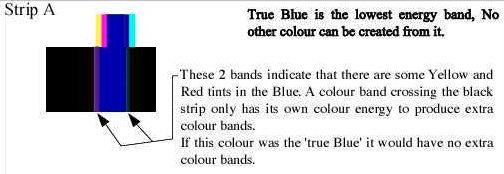
Blue Slit
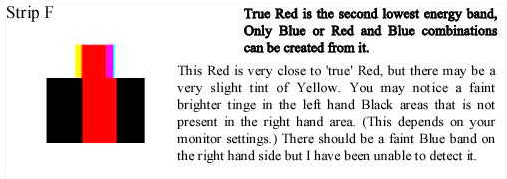
Red Slit

Yellow Slit
Obviously my method of using the computer monitor as the colour source only gives approximations. As a pensioner I am unable to spend £millions on buying equipment. My total outlay on scientific equipment for this series of experiments was under £5.00.
The extra energy added to the colours due to the radiated Black screen energy of 1.5 micro amps made a serious distortion in the colours, particularly the Blues.
Author – Brian Williams
-
Colour Test Bars
Posted on October 13th, 2010 No commentsThe drawing below is one I originally produced some 15 years ago as a cross-check on my theory that the spectrum colours originate from edges. It turned out to give quite a large quantity of information that confirms my theory.
Viewing different areas of the above through a prism gives you the various spectra shown below. I have tried 60°, 45° and 30° prisms and find that a 45° prism gives the best overall results. It is also the most readily available, from old cameras and binoculars.
At first the spectra below don’t seem to make much sense. However, if you bear in mind my previous pages it all starts to make sense. Note that I cannot guarantee the colour accuracy on your monitor or printer, I have had difficulties producing the colours actually seen, and some of the colours are definitely “off colour”. In practice you will probably see some faint strips that I consider to indicate that there is another colour in the pigment or being projected.
Note: The viewing distance between the screen and the prism affects the width of the bands.
It should be remembered that we are dealing with energy levels. A black screen radiates approximately 4.5% of the energy of a White screen, so that this may partly explain the less prominent colour bands, as it is produced from Cyan/Blue, Magenta/Red and Yellow/Green phosphors.
The next 3 sketches explain the colour bands on silhouettes of Blue, Red and Yellow.
It should be noted that a higher energy colour will encroach into part of the space occupied by a lower energy colour.
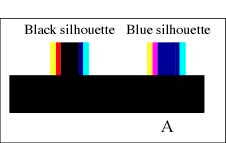 With a black silhouette, (Black being an absence of any colour energy) the Blue light dissipates readily into this area, which sometimes makes it difficult to see. Some Red may also encroach into this area.
With a black silhouette, (Black being an absence of any colour energy) the Blue light dissipates readily into this area, which sometimes makes it difficult to see. Some Red may also encroach into this area.In the Blue silhouette the Blue band becomes part of the silhouette that is radiating the same energy level. The energy gradient from White to Blue is less than the energy gradient from White to Black therefore there is no separate Blue band. The Red band encroaches on the Blue area creating a turbulence we perceive as Magenta.
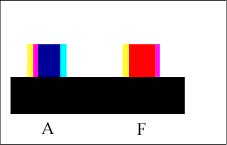 With the Red silhouette the energy gradient is less therefore we lose the Red band.
With the Red silhouette the energy gradient is less therefore we lose the Red band.The Cyan band merges into the Red area creating a turbulent mixture we see as Magenta. The Red band is part of the Red silhouette, which leaves us with a Yellow band.
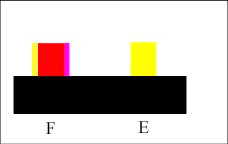 With the Yellow silhouette the energy gradient is only one step, i.e. White to Yellow; therefore there are no intermediate colour bands.
With the Yellow silhouette the energy gradient is only one step, i.e. White to Yellow; therefore there are no intermediate colour bands.Magenta and Cyan.
Now let us consider the ‘oddball’ colours, Magenta and Cyan. Both of these, as silhouettes, give a clean strip without any side bands when viewed through the prism. (Note: There are some very narrow bands but I consider that these are caused by carry-over from the screen phosphors.)
This is due to the high turbulence between White and the Blue in both Magenta and Cyan. The eye/brain cannot accurately determine the ratios of colours due to the fluctuating energies, but is aware of which section of the cones the signals are coming from, and the brain decides that fluctuating energy in the Blue area of the cones plus White light gives us Cyan, and that fluctuating energy in the Blue and Red areas of the cones plus White light gives us Magenta.
Without the high proportion of the White light, the brain can handle the fluctuations giving us Purples, Mauves etc. in various hues.
 Screen or printed colours are a problem. I have not yet been able to reproduce the actual colours obtained from edges and prisms. The White intensity does not affect the primary colours Yellow, Red and Blue. Nor does it affect Cyan and Magenta. I have checked this using a White intensity three times greater than the screen White without any perceived difference.
Screen or printed colours are a problem. I have not yet been able to reproduce the actual colours obtained from edges and prisms. The White intensity does not affect the primary colours Yellow, Red and Blue. Nor does it affect Cyan and Magenta. I have checked this using a White intensity three times greater than the screen White without any perceived difference.It does affect the width and intensity of other colour band combinations. There should be no Yellow in the Magenta but Magenta has approximately the same energy level as Yellow.
As in the Yellow ’slit’ we have the Red band adjacent to the black edge, then a beige colour. (Red and Blue from the Magenta and and a small amount of Yellow from the White component.) On the left side we have a Dark Blue against the black, and then a Mid Blue, ( there is insufficient White to produce Cyan. )
The use of these test bars gives us a method of accurately determining ‘True’ colours and also giving an accurate specification for any colour. At present there are no reliable standards for colours. You can compare colour charts from all sources without getting a match for a stated colour. It also gives us a more reliable method of measuring colour blindness.

Blue Slit

Red Slit

Yellow Slit
Obviously my method of using the computer monitor as the colour source only gives approximations. As a pensioner I am unable to spend £millions on buying equipment. My total outlay on scientific equipment for this series of experiments was under £5.00.
The extra energy added to the colours due to the radiated Black screen energy of 1.5 micro amps made a serious distortion in the colours, particularly the Blues.
Author – Brian Williams
-
Energy of Coloured Light
Posted on October 11th, 2010 No commentsAbout 12 years ago I carried out this simple experiment to assess the energy of coloured light. I connected a photocell to a micro-ammeter and mounted them in front of my computer. I then set up a rectangle in Autocad with a fill colour and zoomed in to give a full screen colour. I then took readings from different screen colours.
The chart below shows the readings obtained. Note;- This is a short version, I am still having difficulty with transferring the larger one which gives far more colours. I will add this when I have sorted the problem out.
This is a very crude experiment and is only approximate. I have 4 computers and the colours show considerable differences on each.
The colours marked A, B and C are the primary colours as seen though a prism, when viewing a wide slit.
I compared these using another prism when taking the readings, and the Red and Yellow are very close, but the Blue is more difficult to determine. This post has been produced on Ubuntu Linux with the drawing done on my old Apple 8500 server. The Blues on the Linux appear a lot lighter.
I checked the energy for a Black screen which gave a reading of 1.5 micro-Amps. This additional energy probably accounts for the difficulties in establishing readings particularly in the low energy range of colours.
Varying the energy level of the White light did not effect the energy levels of the primary colours Yellow, Red, and Blue, marked A, B and C on the chart or its perceived colour.
It did affect the paler Reds and paler Blues indicating that they needed White light to obtain their different colours.
MORE to come on this.
Author – Brian Williams
-
Light Passing Through Dense Media
Posted on October 9th, 2010 No commentsPart of the catechism of the physics establishment is that “Light is slowed when it passes through a dense medium.” As an engineer I find it a refreshing change to find something with which I can agree with the physicists. However, as it is obvious that anything (freely) passing through any medium will slow down, it is not really an earth shattering ‘discovery’. Note: Anything constrained to pass through a medium may in fact be forced to retain its original speed, or even to increase its speed. This point is of particular importance in explaining some colour phenomena.
The important point about the statement is in its relationship to experiments carried out to verify it.
White light passing through different lengths of ‘dense’ medium, showed different colours depending on length.
The light exiting from the longest length of ‘dense’ medium was blue.
The physicist’s conclusion from this fact is that only the blue light had sufficient energy to pass through the dense medium! Note: This is one of the ‘proofs’ claimed by physicists of the higher energy of blue light.
Let us look at this conclusion. Consider 3 lengths of a ‘dense’ medium.
Length No.1 (the shortest) emits only yellow light.
Length No.2 (the mid length one) emits only red light.
Length No.3 (the longest) emits only blue light.
The energy of the light exiting the dense media gives Yellow as the highest and Blue as the lowest energy.
The bottom strip is really a true (possible) spectrum. If you removed the interface colours, Orange and Purple you would be left with a perfect spectrum of White, Yellow, Red and Blue. Note:- This is only a spectrum relative to the human eye, other creatures may have different ranges.
But according to the physicists only Blue light has the energy to pass through the longest length!
Any engineer who proposed such a naïve conclusion would have been demoted to tea-lad, (Under supervision.). If we equate the above filters with water passing through a pipe, then the physicists conclusion would be that if water coming from the end a 10mile x 1” diameter pipe was only at low pressure then this meant that only low pressure water had the energy to travel that length of pipe!
For those of you who (like physicists) have never had any interest in mechanics, the water pressure in your pipes depends on how far you are from the supply pumps. If you are within a few hundred feet from the pumps your water pressure is very high, if 10 miles away , very low. This is because energy is lost due to friction and other reasons. The same thing applies to light.
Oddly enough, (or logically), you do not get Cyan, Green, Magenta, Mauve, etc., etc, you only get White, Yellow, Red and Blue and interface mixtures such as Pale yellow, (Between White and Yellow) Orange, (Between Yellow and Red), and Purple, (Between Red and Blue). You do not get Cyan because Cyan is a mixture of White and Blue, and in the experiment this cannot happen because of the intervening Yellow and Red bands. You do not Green because Green is a mixture of Yellow and Blue and this cannot happen because of the intervening Red band. You do not get Magenta because Magenta requires compression, a situation that I will explain later.
In the magnificent photograph below you see an example of light passing through a dense medium. It shows a cloud layer passing over an active volcano. [This photograph was passed to me by e-Mail, from an unknown source. Over a year I get thousand of photographs with no information on the source]
Where the cloud layer is thinnest, bright Yellow is seen. As the cloud gets thicker, the colours go through deeper Yellow then Orange then Red then Purple. Interestingly, where the sun is shining on top of the cloud layer a dark Brown/Khaki is seen. You are seeing this by projected light from your computer. you would be seeing the photograph by reflected light. The only difference between the two is due to limitations of colour handling of your monitor and the limitations of photo printing.
Author- Brian Williams
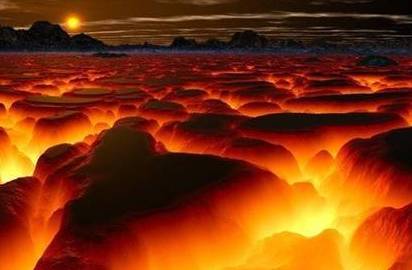
Volcano Cloud
-
Rainbows
Posted on July 26th, 2010 No commentsThe physicists claim that rainbows are created by light being split into different colours by tiny droplets of water. This is only partially true. If you shine White light into a droplet of water you get White light. If there is an edge between the droplet and the light, or an edge visible through the sphere then you get distorted coloured bands. Coloured light entering a droplet of water is distorted in a similar way that coloured light entering a prism is distorted.
Where are the edges up in the sky to create these colour bands? These are provided by the droplets of water themselves. If you shine White light onto a droplet of water a shadow is formed behind it. The edges of this shadow create thin colour bands (Blue, Red and Yellow) that pass into droplets of water behind it and are distorted and enlarged. After that it becomes complicated as the coloured bands pass through millions of water droplets.
It is easy enough to check this with the use of a couple of brandy glasses filled with water.
-
Lightning strikes upwards!
Posted on July 24th, 2010 No commentsI was giving informal lectures on this over thirty years ago. Yes, lightning does strike upwards. This was an obvious requirement, as there is a build up of electrons on the surface of the Earth and electricity travels from negative to positive. Visual ‘evidence’ indicates that it travels downwards. High speed photography indicates that lightning travels downwards.. However, the physicists have missed the vital point that the eye or the photography are only seeing the light created by the lightning strike, they are not seeing the actual lightning. An electrical charge is electricity and it is static, lightning is electricity and is moving. The electrical charge on the Earth is static, but under the influence of a positive charge it becomes lightning. The change from a ‘charge’ to lightning requires acceleration, it is not instantaneous. (Basic mechanics)
Now Physics or Fantasy, Section 1 shows conclusively that light does not travel at a constant speed. In fact light travels at various speeds, Blue light travels slower than Red light which travels slower than Yellow light which travels slower than White light. White light travels at a vast range of speeds. The same applies to electricity.
Lightning is accelerating during its passage from the Earth to the clouds. Close to the Earth it is travelling quite slowly, therefore its speed of passage creates only low energy light. On entering the cloud layer it is travelling at its highest speed, and therefore creates a higher energy light. The higher the energy of the light the faster it travels. We therefore see the light created at the cloud height before we see the light created at low level. Therefore the lightning appears to travel downwards. No, this does not prove Einstein’s time dilation, it is just basic mechanics.
The lightning strike passing through the atmosphere my be considered to be like a bullet passing through some very light objects. The bullet scatters the light objects in all directions. The speed of scattering of the light objects is considerably less than the speed of the bullet. Unlike a bullet, lightning is constantly accelerating until it reaches the centre of the positive attraction in the cloud layer. It is therefore almost certain that a lightning discharge travels considerably faster than light.
Recent photographs taken from aircraft travelling above the cloud layers, show lightning apparently striking upwards from the cloud layer. This has created much confusion. However, lightning striking a cloud layer from below may not have all its energy absorbed within the cloud, and part of the energy may continue through it to appear as short lightning ‘strikes’ above the cloud layer. This new evidence is certainly indicative that my early thoughts on this were correct. Obviously I may not be correct, but a logical explanation is better than waffle.
Note; If lightning is electricity and electricity is electrons, then you should not be able to see lightning if light is photons, unless electrons create photons!!!
Lightning can also occur within the clouds. Although we speak of positive and negative, positive should really be considered as ‘Less Negative’. A negative charge is a a supply of free electrons. These will attempt to redistribute themselves into areas with less electrons, i.e. ‘less negative’ areas. Clouds will generally have areas that are less negative than others and therefore there will be lightning strikes within the cloud layers.
Brian Williams – Author.
-
Complimentary Colours
Posted on April 1st, 2010 No commentsTry these simple experiments.
1. Stare at a Yellow coloured shape for about 30 seconds and then look at a white sheet. Make a note of what you see. Answer 1A
Carry out the same experiment again, but this time make a note of the background colour surrounding the shape. Answer 1B
Carry out the second experiment again but whilst still noting the background colour, note the colour of the shape. Answer 1C
2. Carry out the same experiments again but using a Red shape. Answers 2A, 2B, 2C
- Carry out the same experiments again but using a Dark Blue shape. Answers 3A, 3B, 3C.
Also carry out the same experiments, but instead of looking at a white sheet, just close your eyes.
It is essential that you carry out these experiments yourself without any input from me, otherwise I would be rightly accused of leading you.
The apparently strange results are due to the mechanics involved in the structure of the eye.
It could be advantageous to everyone (including me) if your results were published on this website so that the results would be available to all, and I could proceed to the next stage with a some independent experimental results.
Sadly, I have not received a single reply on this posting in 12 months.
-
Printer Colours
Posted on March 16th, 2010 No commentsThe printer colour cartridges Yellow, Magenta, and Cyan, are actually pale Yellow, pale Red ( Although some do have a small percentage of Blue) and pale Blue. They depend on the White of the paper and Black to create the various colour approximations.
In the lighter Yellow range control is by reducing the ratio of Yellow spots to allow more White to show through. In the darker Yellow range control is by adding varying ratios of Red or Black spots. If only Black spots are added it gives an impression of a darker Yellow, but if Red is added it gives an Orange/Yellow Ochre impression which people still consider to be Yellow. An artist will tell them differently.
In the lighter Red range control is by reducing the ratio of Red spots to allow more White to show through. In the darker Red range control is by adding varying ratios of Blue or Black spots.
In the lighter Blue range control is by reducing the ratio of Blue spots to allow more White to show through. In the darker Blue range control is by adding varying ratios of Red or Black spots. Black only gives a darker Blue.
Red only gives such Blues as Royal Blue etc. which have a higher energy than ‘true’ Blue.
Many papers have a distinct Yellow tint, and the White energy of ambient light, both affect our viewing of the finished print.



